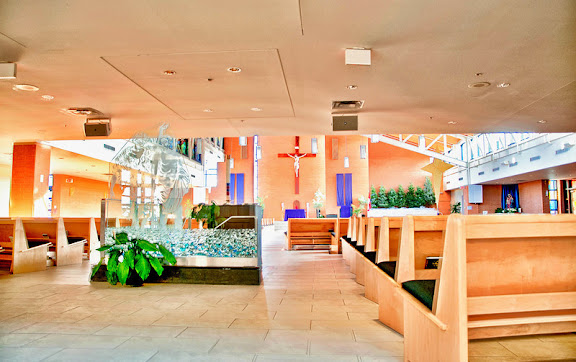Baptism is a central part of the Catholic experience. Through this sacrament we are cleansed of sin, welcomed into the Church family, and reborn into new life in the Holy Spirit. Because of baptism's importance, many churches have a special area known as a baptistery within the sanctuary, which is a special area for the baptismal font. The font is a basin or pool of water that can appear in many different forms, as shown below.
The first baptisms would have happened in places like the River Jordan, where Jesus was baptized. A few centuries later, when churches were built, baptisms took place in nearby but separate baptisteries. Some examples still survive in Europe, including the Baptistery of St. John Lateran in Rome, the Baptistery of St. John in Florence, and the Baptistery of St. John in Poitiers. At that time, people were still immersed in the water during the sacrament. Eventually, when water was sprinkled or poured on the candidate, a smaller font was able to be used and the rite was moved into the sanctuary.
Since the Second Vatican Council, there has been a trend towards placing larger immersion pools in the sanctuary. As Monsignor M. Francis Mannon puts it, "Baptism by immersion makes tangible the theological motif of baptism as going down into the waters of death and rising again with Christ; it underscores the Exodus theme of crossing the Red Sea from slavery to freedom; it provides visible expression of baptism as encounter with the tomb of death, and the womb of new life."
The fonts shown below reflect different aesthetics and artistic sensibilities, but many of the same symbols are used. Fonts are often displayed with the paschal candle, which is representative of the light of Christ coming to the world. During the baptism, a smaller candle is lit from the paschal candle and presented to the newly baptized to represent the reception of the gift of the Holy Spirit.
Most of the images below are from a series of photos that were taken in 1986:
Bonus: The immersion pool at St. Francis Xavier Parish, Mississauga:
Which is your favourite?
Most of the images below are from a series of photos that were taken in 1986:
 |
| All Saints Parish, Etobicoke 1986 PH78/3S |
 |
| Images of the Holy Family are a common motif for baptisteries. Blessed Sacrament Parish, Toronto 1986 PH 78/6S |
 |
| Fonts are frequently octagonal in shape. In Christianity, the number eight represents new life. Holy Rosary Parish, Toronto 1986 PH78/24S |
 |
| Images evoking water and aquatic life are often seen in baptisteries. Our Lady of the Assumption Parish, Toronto 1986 PH 78/35S |
 |
| Some fonts allow for flowing water, which recalls early baptisms in natural bodies of water. Our Lady of Fatima Parish, Brampton 1986 PH 78/37S |
 |
| The imagery of the dove in this baptistery also comes from the baptism of Jesus, when the holy spirit descended in that form. Our Lady of Mount Carmel Parish, Toronto 1986 PH 78/S |
 |
| Our Lady of Peace Parish, Toronto 1986 PH 78/46S |
 |
| St. Clare's Parish, Toronto 1986 PH 78/88S |
 |
| Baptistery windows. St. Joan of Arc Parish, Toronto 1986 PH 78/112S |
 |
| Sts. Martha and Mary Parish, Mississauga 1986 PH 78/145S |
 |
| St. Patrick's Parish, Toronto 1986 Ph 78/164S |
 |
| St. Paul's Basilica, Toronto 1986 PH 78/173S |
 |
| St. Clare of Assisi Parish, Woodbridge 2008 Cultural Heritage Inventory |
Bonus: The immersion pool at St. Francis Xavier Parish, Mississauga:
 |
| Photo from the St. Francis Xavier Parish website. |
Which is your favourite?


No comments:
Post a Comment